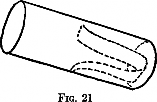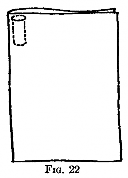
6. DYEING THE SILKS
The dyeing silk handkerchiefs by simply passing them through a paper tube, invented by David Devant a number of years ago, is still one of the best tricks with silks. The original method has been described so often that will content myself with the explanation of some recent modifications.

The special gimmick, a small metal tube with a tape as long as itself fastened across it at the middle, is still used (Fig. 21). Silks pushed in at one end are prevented by the tape from emerging at the other end. If, however, other silks are pushed in at the opposite side, the first silks will be forced out and the new ones will take their place inside the tube. By having the gimmick made with a gutter along one side, large enough to take the performer’s wand easily, the paper tube can be proved to be empty after the gimmick has been loaded in—at any rate, by magicians logic. He takes his own handkerchief from his pocket—a small one, by the way—pushes it into the gutter, and with his wand pushes it right through the paper tube. The silks to be dyed go into the gimmick itself, with the usual result.

Another method is to have the gimmick just large enough to take two medium-sized silks. This is concealed in the fold of a full sheet of a tabloid newspaper, at the back (Fig. 22).
The doubled sheet is shown as a single sheet only, the gimmick being held in place with the fingers between the two thicknesses of the paper. This is rolled into a tube which can be shown with its mouth toward the spectators, the fingers inside hiding the bulge caused by the gimmick. Three silks are shown and two are apparently pushed into the tube, really into the gimmick between the two thicknesses of the paper; as soon as the second is safely home and the two colored silks have been pushed out, the gimmick is allowed to slide into the hand and is disposed of in taking the third silk. This one is simply wrapped around the paper tube to keep it from unrolling.
In due course the dyed silks are extracted, the silk round the tube is removed, and the paper tube torn to little pieces. As a final touch the performer pulls this last silk through his hand and it changes color. This is simply another use of the well-known color-changing handkerchief.

The latest development of the trick is a self-contained tube and gimmick combined. A sheet of very thin black cardboard, about ten by twelve inches is cut into the shape shown in Fig. 23. The part ABCD is rolled into a tube and the edge AC is glued to the main sheet. The usual tape is then fixed in the middle of this tube. The tube is rolled up with the sheet around it and kept in that condition so that whenever it is opened out and then released it will automatically roll itself around the gimmicked part. The method of working is sufficiently obvious.
The tube is loaded with silks in the usual way; when the sheet is unrolled toward the audience, the fingers hide the gimmicked section and the spectators naturally think they see the whole sheet. This is then again rolled round the small tube, the silks are pushed in, the colored silks emerge, and once more the sheet is unrolled and shown free from guile.
Website Content: © Copyright 2024 by Trickshop.com.